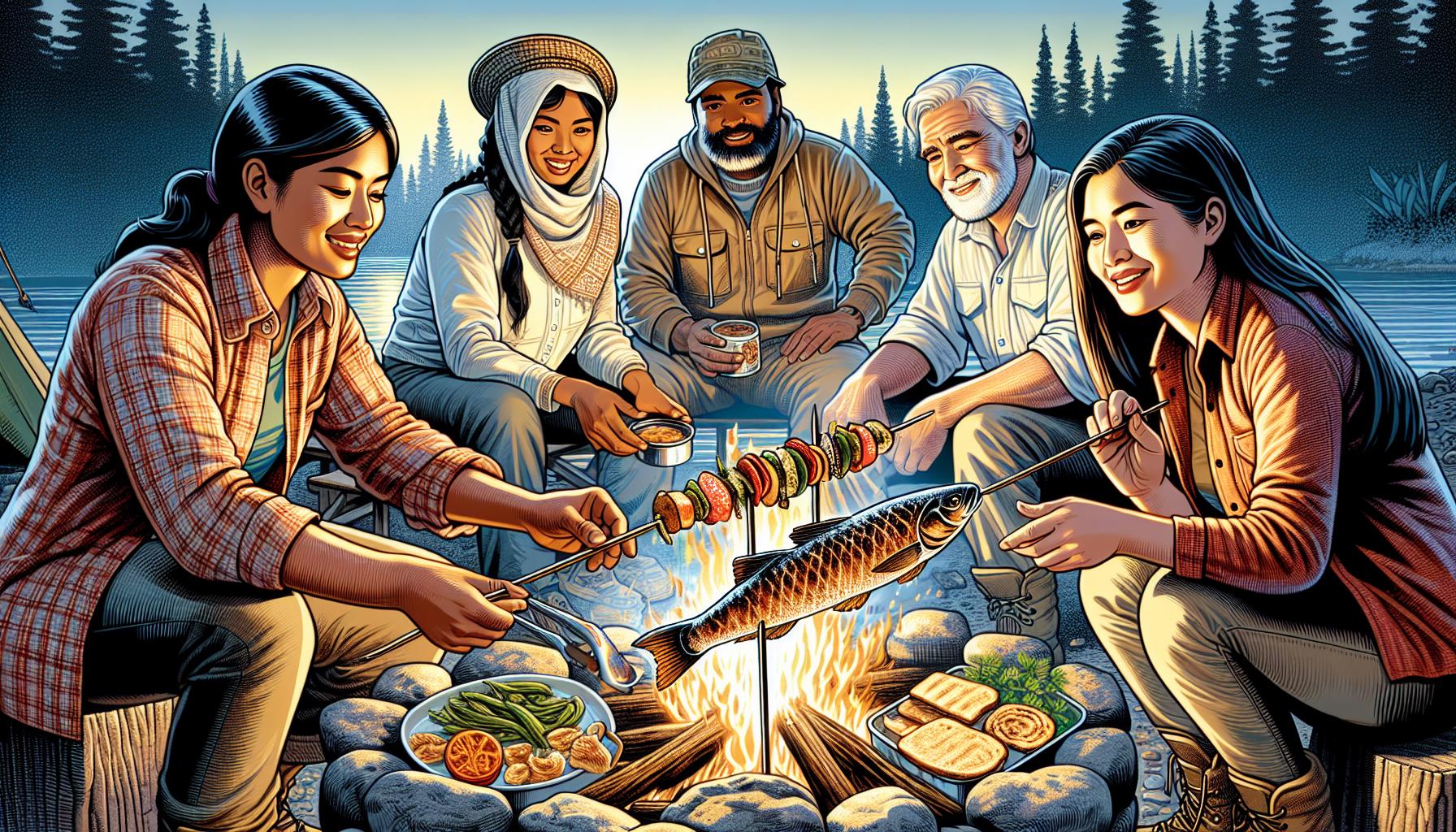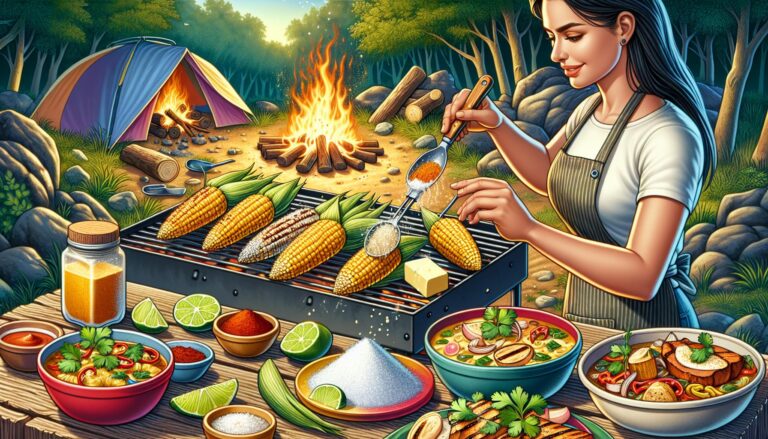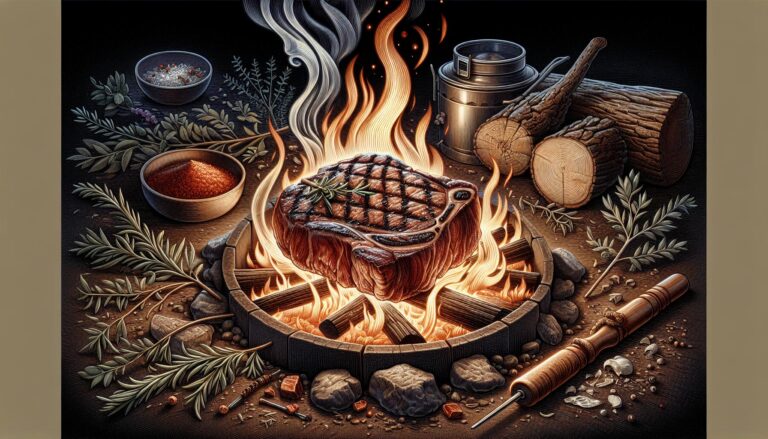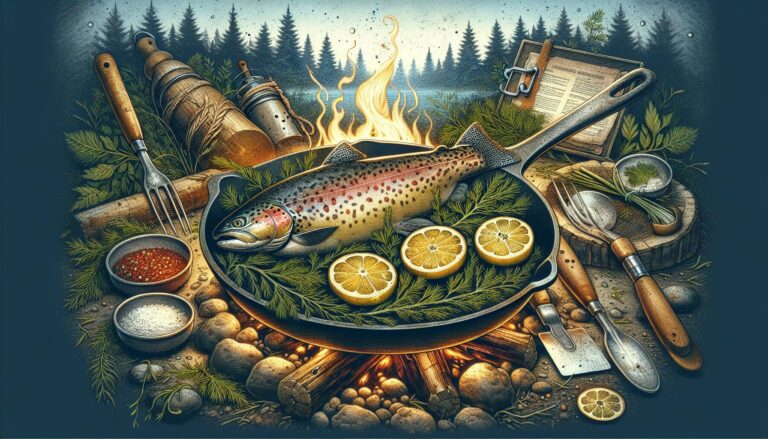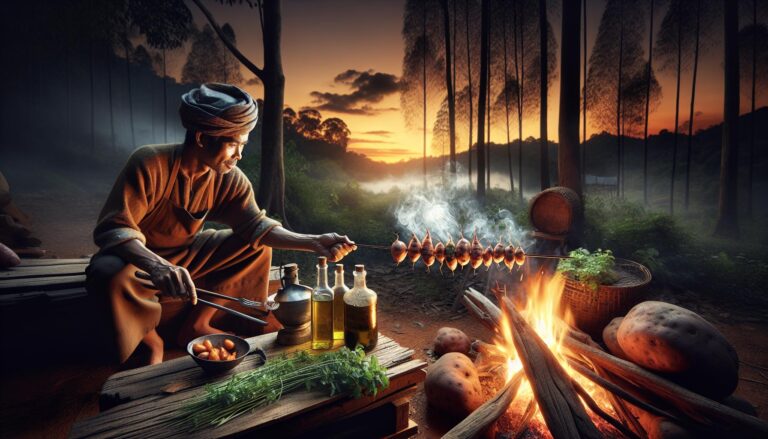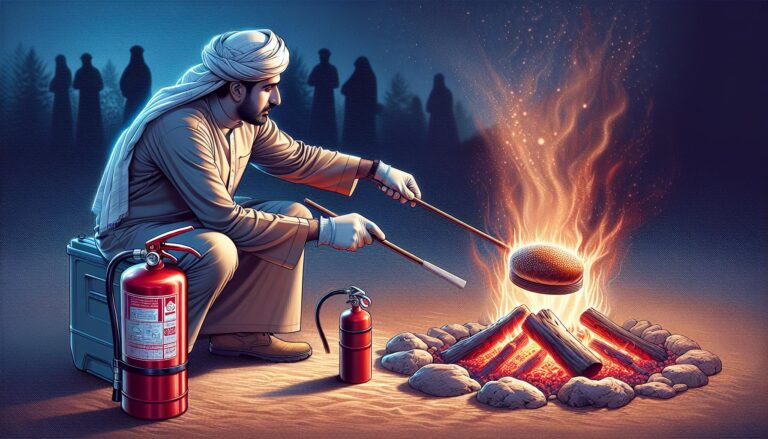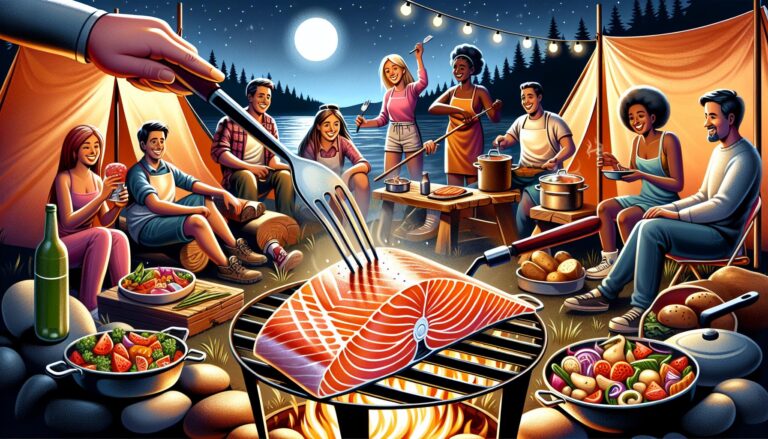Campfire Fish Cooking Guide: Perfect Grilled Catch
Cooking fish over a campfire is an art that marries the rustic charm of the outdoors with the delicate flavors of fresh catch. Whether you’re a seasoned camper or a novice to open-flame cooking, there’s nothing quite like the satisfaction of enjoying a meal you’ve prepared over a crackling fire.
You’ll find that with the right techniques and some simple tools, you can turn your campfire into a gourmet kitchen. Get ready to impress your fellow campers with perfectly cooked, smoky-flavored fish that’ll make your outdoor adventure unforgettable.
TLDR: Master the art of cooking fish on a campfire with easy techniques and tools for a delicious, smoky-flavored meal in the great outdoors.
Choosing the right fish
Cooking fish over a campfire is as much about the quality of your ingredients as it is about the technique. The type of fish you select can greatly influence the flavor and success of your meal. It’s crucial to make an informed choice to ensure your dish is both delicious and memorable.
Fresh Over Frozen
When you’re aiming to impress with your campfire culinary skills, freshness is key. Fresh fish tends to have a superior taste and texture, which is particularly noticeable when cooked over an open flame. The smoky flavors from the campfire can elevate the natural nuances of fresh fish, making your meal unforgettable.
But what if fresh isn’t an option? Frozen can be a viable alternative, especially if it was frozen shortly after being caught. Make sure to thaw it properly – in the refrigerator or in cold water – to maintain its quality. However, if you have the choice, always opt for fresh fish; it’ll offer the best possible results for your campfire feast.
Selecting the Right Type
Not all fish fare equally when exposed to the intense heat of a campfire. You’ll want to choose a type that’s robust enough to withstand direct heat.
Here are some types that are ideal for campfire cooking:
- Salmon: With its rich flavor and hearty texture, salmon holds up well against the heat. Its oils also add a wonderful flavor when grilled.
- Trout: A classic choice for campfire cooking, trout responds beautifully to the smokiness of the flames.
- Bass: Firm-fleshed and flavorful, bass is another excellent choice that won’t fall apart on the grill.
Lighter, flakier fish like cod or tilapia might not be the best candidates for direct flame cooking, as they can easily overcook or fall apart. For these, consider using a cast-iron skillet on the campfire for a more controlled cook.
Remember, the key to selecting the right type of fish is considering how it pairs with the cooking method. Tougher, oilier fish typically manage better, leaving you with a wonderfully smoky and intact dish. Your goal is to harmonize the fish’s natural flavors with the rustic charm of the campfire, and selecting the right type is the first crucial step in this tasty journey.
Preparing the fish

Once you’ve chosen the perfect type of fish for your campfire cooking, it’s essential to prepare it properly to ensure the best taste and texture. Correct preparation enhances the fish’s natural flavors and ensures it cooks evenly over the open flame.
Cleaning the Fish
Before anything else, you’ll need to clean your fish. Start by rinsing your fish thoroughly with freshwater to remove any debris or slime. This step is crucial for both fresh and thawed frozen fish. Lay the fish on a flat surface, use a small, sharp knife, and always keep your hands away from the blade to avoid injury.
Scaling the Fish
If you’re dealing with a scaly fish, you should remove the scales for a better dining experience. Hold the fish by the tail and use a fish scaler or the back of your knife blade. Scrape from the tail to the head, repeating until all scales are gone. Work under running water to minimize mess and make the process smoother.
Gutting the Fish
Gutting is necessary to remove the fish’s innards, which can harbor bacteria and spoil the flavor. Make a shallow cut from the anus up to the base of the gills. Reach in and pull out the entrails carefully. Once emptied, rinse the cavity to clean out any remaining blood or guts. Your fish is now ready for the next step.
Filleting the Fish
If you prefer boneless pieces or have a large catch, filleting is the way to go. Start at the tail and cut along one side of the spine, moving towards the head. Keep your knife close to the bones to get as much meat as possible. You may also remove the skin at this stage if preferred.
Remember, each step in preparing your fish is essential to achieving that perfect campfire meal. Proper handling will ensure your fish retains its integrity for a delicious, rustic experience.
Building the campfire
Selecting the Right Spot
When you’re getting ready to cook your fish, the first thing you’ll need to do is choose the perfect location for your campfire. Look for a spot that’s safe and flat, ideally made of dirt or sand. You’ll want to be at least 15 feet away from tents, trees, and any other flammable materials to prevent the spread of fire. Pay attention to the wind direction to keep smoke and ashes away from your cooking area and seating.
Gathering the Firewood
Next up, it’s time to collect firewood. You’ll need three types of wood:
- Tinder: Dry materials like pine needles, leaves, or small twigs that’ll catch fire easily.
- Kindling: Slightly larger sticks, usually less than an inch in diameter, that can burn longer and help build your fire.
- Fuelwood: The largest pieces of wood that will keep your fire going strong for cooking.
Always gather wood that’s fallen and dry; green or wet wood will create a lot of smoke and won’t ignite well. Also, be mindful of the environment and use what’s already fallen to avoid damaging live trees.
Creating a Fire Pit
Once you’ve secured your wood, it’s time to make a fire pit. Clear a circular space about 4 feet in diameter. Dig a shallow pit about 6 inches deep in the center. This will help shield your fire from the wind and keep the coals hot. Surround the pit with a ring of rocks to contain the fire and prevent it from spreading.
Building and Lighting the Fire
Building the fire follows a simple, yet effective, method. Start by laying a small pile of tinder in the center of the fire pit. Then, use your kindling to form a teepee around the tinder. Light the tinder with a match or lighter and gently blow to encourage the flames. As the kindling catches, gradually add larger pieces of fuelwood, taking care not to smother the flames. You’ll know the fire is ready for cooking once you have a bed of glowing coals with a low flame. At this point, you’re all set to cook your fish over the campfire and enjoy the flavors that come from this time-honored cooking technique.
Cooking the fish
Once you’ve got your campfire burning steadily, it’s time to turn your attention to the main event: cooking the fish. You’ll want this to be a memorable part of your adventure, and with the right preparation and approach, it’s guaranteed to be a success.
Preparing the Grilling Surface
To ensure your fish cooks evenly, preparation of the grilling surface is key. If you’re using a grate, make sure it’s clean and positioned at a reasonable distance from the coals. You’re aiming for a medium-hot temperature; if you can hold your hand above the grill for 5 seconds before it feels too hot, you’ve hit the sweet spot.
- Position the grate over the fire
- Let it heat up for a few minutes
- Oil the grate to prevent sticking
Seasoning the Fish
Good seasoning can take your fish from good to great. Here are some simple yet effective ways to add flavor to your fresh catch:
- Sprinkle salt and pepper on both sides
- Rub with garlic or lemon for added zing
- Consider marinating the fish for a few hours prior
Less is more when you’re out in the wild. Fresh fish has a wonderful flavor that you don’t want to overpower with too many spices.
Placing the Fish on the Grill
Once your grilling surface is ready and your fish is seasoned to perfection, it’s time to start grilling. Lay the fish gently on the grill, skin side down if it’s filleted. This prevents the fish from falling apart and allows it to get that delicious, crispy skin.
Remember not to overcrowd the grill; give each piece enough space so the heat can circulate properly.
Monitoring the Cooking Time
Cooking times will vary depending on the thickness of the fish. As a general rule, aim for 10 minutes of cooking time per inch of thickness. You’ll know the fish is done when it flakes easily with a fork but is still moist inside.
- Keep an eye on hot spots to avoid burning
- Flip the fish only once to maintain its integrity
- Cover with foil if you need to manage flare-ups
Cooking fish on a stick instead
Selecting a Stick
Choosing the right stick is critical when you’re opting to cook fish over a campfire using this rustic method. Look for a sturdy and straight stick that’s about an inch in diameter. Hardwood sticks like oak or maple are your best bet as they are less likely to burn quickly or break under the weight of the fish. Make sure the stick is long enough to keep your hands safely away from the flames, ideally around 2 feet.
Putting the Fish on the Stick
Before skewering the fish, remove any leaves or bark from the stick and sharpen the end with a knife to make it easier to insert. Slide the fish onto the stick lengthwise to ensure it’s securely held. If you’re cooking smaller fish, you can skewer them through the body, but for larger fish, you might need to use two sticks crosswise to support the weight evenly.
Knowing When the Fish Is Done Cooking
The key to perfectly cooked fish on a stick is to rotate it regularly so that it cooks evenly on all sides. The fish is done when the skin is slightly crispy and the flesh flakes easily with a fork. This could take anywhere from 10 to 15 minutes, depending on the thickness of the fish and the intensity of the fire. Be mindful to not overcook as fish can quickly become dry.
Removing the Fish from the Stick
Once the fish is cooked to perfection, carefully remove it from the stick to avoid any burns or dropping it into the fire. Use a pair of tongs or a heat-resistant glove to hold the stick. Gently slide the fish off the skewer onto your plate. Be cautious of any hot juices or steam that might escape as the fish is removed.
Enjoying the meal
Serving Suggestions
After you’ve masterfully cooked your fish using a stick over the campfire, you’ll want to serve it in a way that complements your outdoor dining experience. Here’s how:
- Plate your fish on a clean surface: Use a flat stone, a wooden plank, or eco-friendly plates.
- Utensils: Ideally, have a fork or a makeshift wooden equivalent to flake away the tender meat.
- Presentation: Garnish with available herbs or edible flowers for a natural touch.
Always ensure that your hands and utensils are as clean as possible to avoid contamination.
Accompaniments and Side Dishes
A campfire meal isn’t complete without the perfect accompaniments. Consider these simple, yet satisfying options that need minimal preparation:
- Roasted Vegetables: Wrap potatoes, carrots, or corn in foil and cook in the embers.
- Campfire Bread: Prepare dough ahead and bake it on the coals for a hearty addition.
- Salads: Bring pre-washed veggies to toss up a quick, refreshing salad.
Keeping your sides simple allows the flavor of the freshly cooked fish to shine through.
Sharing Stories Around the Campfire
As you savor your meal, engage in the timeless tradition of storytelling. Sharing stories can enrich your experience and create lasting memories.
- Fishing tales: Relive the thrill of the catch by recounting your fishing adventure.
- Local legends: Research the area before your trip and fascinate your companions with local myths.
- Personal memories: Bond with others by sharing past camping experiences or dreams for future adventures.
The warmth of the campfire paired with engaging tales makes for the perfect ending to your day. Make each moment count, and let the stories flow as freely as the night sky above.
Conclusion
Mastering the art of campfire cooking elevates your outdoor adventures to new heights. With your freshly cooked fish, complemented by a side of roasted vegetables or a crisp salad, you’ve got a meal that’s as satisfying as it is memorable. As the flames flicker and the stars begin to dot the sky, share stories and create moments that last a lifetime. Embrace the simplicity of nature’s kitchen and let the magic of the campfire infuse every bite with flavor and nostalgia. Now go ahead, savor your culinary creation and let the great outdoors be your dining room.
Frequently Asked Questions
What is the best way to cook fish over a campfire?
Cook fish over a campfire by skewering it on a stick or using a grate. Ensure the fire has reached a bed of coals for even cooking and rotate the fish for a thorough cook-through.
How should the cooked fish be served?
Serve the cooked fish on a clean plate or surface, using utensils to flake the meat away from the bones. Consider adding garnishes like herbs or edible flowers for flavor and presentation.
What side dishes complement campfire-cooked fish?
Roasted vegetables, campfire bread, and fresh salads make excellent sides for campfire-cooked fish. They are simple to prepare and add variety to the outdoor dining experience.
Is there a cultural aspect related to cooking fish over a campfire?
Yes, cooking fish over a campfire often involves the tradition of storytelling. Sharing fishing tales, local legends, and personal memories around the fire enriches the experience and creates lasting memories.
Why is it important to create memories while cooking over a campfire?
Creating memories around a campfire is important for bonding with friends and family, relishing the outdoors, and enjoying the warmth and communal spirit of the fire. It’s an experience that goes beyond food, encapsulating tradition and camaraderie.
